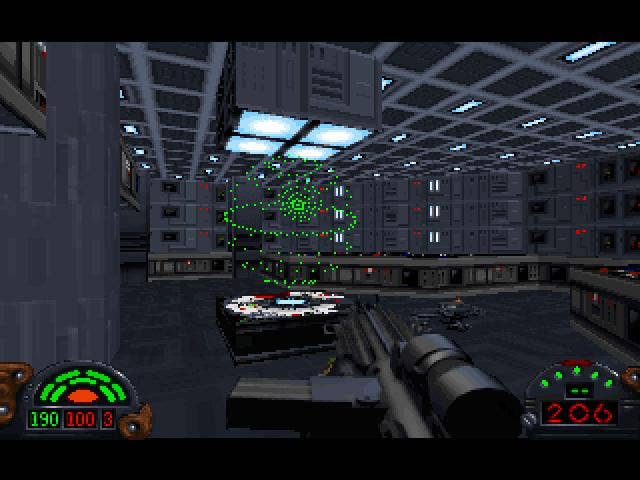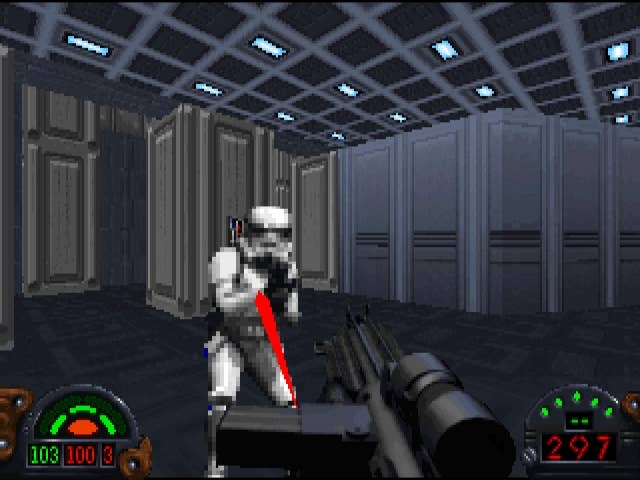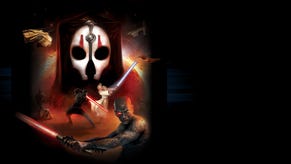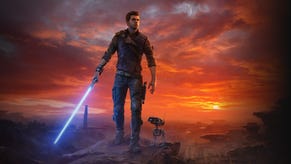"The Greatest Star Wars Game Ever": Dark Forces
It's May the 4th! Here's one of our favorite Star Wars games ever!
This article first appeared on USgamer, a partner publication of VG247. Some content, such as this article, has been migrated to VG247 for posterity after USgamer's closure - but it has not been edited or further vetted by the VG247 team.
This article was original posted in 2015. In honor of May the 4th, we're republishing it here.
I'm really looking forward to the premiere of The Force Awakens this week, even though Disney's really trying to suffocate my interest with its out-of-control marketing. We go back a long way, Star Wars and I—the original was the first film I can ever remember seeing at a theater, probably around 1981 or so. (Do drive-ins count as theaters?) Try as Disney might to kill my interest in the series with a cavalcade of terrible commercials and product tie-ins, I'm holding out until at least this weekend before giving up.
If I had one wish about Star Wars, it's the people behind the public manhandling of the brand would put a little less effort into sneaking Stormtroopers and lightsabers into every possible second of commercial real estate on television and instead invest that energy into making it easier for me to play what, in my opinion, is the greatest Star Wars game of all time: 1995's Star Wars: Dark Forces. How was it that I could play this game on a Mac 20 years ago, when everyone was abandoning the platform left and right, but here in the Year of Our Lord 2015 when Apple is the most pervasive brand in the world (outside Star Wars, I mean) such a task is nigh-impossible? You can grab Dark Forces for Windows on Steam, and GOG.com even lets you buy the Linux version! But a version compatible with modern Macs is nowhere to be found.
Such a shame! In my opinion, Dark Forces is the single best thing anyone's ever done with the Star Wars license in video game form. Yeah, I know, there are plenty of games that are technically better, or truer to the spirit of the series. What those games lack, however, is the timing and content to have made a huge impression on me, personally. It also came along early enough in LucasFilm's "expanded universe" push that a lot of the things it attempted to do narratively felt fresh and surprising rather than tiresome and hackneyed.
For example: Dark Forces begins with a one-man infiltration of an Imperial base. We'll forgive the game the notion that a guy with a blaster can take out an entire Imperial legion, because such is a mechanical necessity of the first-person shooter genre (or as we called 'em when Dark Forces arrived, "DOOM clones"). This wasn't meant to be a 100% accurate and canonical addition to Star Wars but rather an inspired effort to marry LucasArts' biggest in-house brand to the shooter format that had exploded in popularity in 1994. As cash-ins on the DOOM craze went, it was easily one of the best in terms of game design; the fact that it brilliantly dropped players into the middle of a visually and sonically faithful tapestry of Star Wars aesthetics made it even better.

Anyway, that base infiltration was the first of many, many attempts to create a game around the theft of the Death Star plans and their transmission to Leia Organa on the Tantive IV. According to the Star Wars wiki, there have been more than a dozen different attempts to explain how those plans ended up with Leia, all contradictory and all due to be mooted in about a year when Rogue One establishes an official explanation. One of the defining hallmarks of the Star Wars expanded universe was that despite the sheer immensity of the films' galaxy, nearly every story existed in the orbit of the movies, constantly referencing back to the text of the original (and later prequel) trilogy. This had the unfortunate effect of making the expanded universe feel trivial and small, but at the time of Dark Forces' debut that disease hadn't yet set in on the realm of LucasArts-sponsored commercial Star Wars fan fiction.
So, the idea of swiping the Death Star plans felt new and interesting at the time. So, too, did taking a side excursion to Jabba the Hutt's prison cruiser and shooting it out with Boba Fett. And besides, Dark Forces didn't actually make its supplication to the movies the primary focus of its tale; it used the Death Star plans as a tangent to deviate from the world of the movies and venture off its own direction. It managed to include a wide variety of settings, including an ice world that wasn't Hoth and didn't involve launching tow cables at AT-ATs (something that was already trite by 1995). Dark Forces ultimately culminated in a showdown against a rogue Imperial admiral who had embarked on a plan to create "Dark Troopers," robotic soldiers infused with the dark side of the Force (one of the few early expanded universe ideas that actually worked better after the prequel trilogy, what with those films' emphasis on droid armies).

Protagonist Kyle Katarn ultimately saves the day single-handedly, because it's an FPS, but the overall concept was strong and offered a great excuse to go traipsing through a number of wonderfully authentic-looking Imperial bases, blasting Imperials and familiar-looking aliens alike with Stormtrooper rifles, thermal detonators, and more exotic weapons. The game's designers also had the good grace not to try and integrate lightsaber combat into the sandbox, allowing Dark Forces to exist as a pure shooter; its sequels would decide to make Katarn into a neophyte Jedi, but here in the infant days of the FPS genre LucasArts wisely kept to the basics.
Dark Forces was one of the more sophisticated early efforts at the FPS. Its story advanced through interstitial cutscenes between levels, rendered in that classic ’90s LucasArts style with iMUSE audio, chunky pixel art, and perfectly tolerable voice acting (though as always, its Darth Vader was clearly no James Earl Jones). The shooting mechanics featured a huge array of different weapon types; though nothing Katarn wielded was quite so ostentatious as DOOM's BFG-9000, there was greater diversity in its application of weapons; I.M. mines and thermal detonators, for example, weren't used as guns but rather as passive traps and grenades, respectively, offering more strategic combat options. Katarn could also gather a remarkable amount of support gear to use in battle, including a gas mask and infrared goggles. And yeah, Stormtooper rifles were hilariously inaccurate.
Dark Forces used a "2.5D" engine similar to DOOM's, but it was one of the first games to include actual elevation as a play feature. Where DOOM offered the illusion of multiple levels, it lacked any kind of vertical aiming control; the Marine would simply fire upward automatically to shoot a Baron of Hell on a ledge. Katarn had to aim manually to target enemies on different levels, and Dark Forces made enthusiastic use of verticality. At its worst, this meant a slightly annoying jumping sequence on the ice planet; at its best, it led to a memorable descent into a deep, dimly lit pit where the first of the Dark Troopers lay in wait, and a shootout with Stormtroopers on ledges that hearkened back to the Death Star chasm swing from the first film.

And, again, the overall importance of the Star Wars aesthetic to the game can't be overstated. You have to cast yourself back to the dim and distant year of 1995 in order to fully appreciate it, though. The Star Wars brand had basically died a decade prior; after Return of the Jedi, nothing of any real interest happened with the property—the Saturday morning cartoons lost steam, the toys dried up at retail, the Marvel comic petered out, and those made-for-TV Ewok movies pounded an enthusiastic nail in the franchise's coffin. About the only thing happening for Star Wars throughout the late ’80s were the tabletop game rule books, which had remarkable latitude to run with the stagnant property. I didn't play the game, but occasionally I'd thumb through the rule books and soak in all the details of this largely forgotten film franchise I'd loved as a much smaller version of myself.
Dark Force arrived as part of Lucas' attempt to build the brand up again throughout the ’90s as a lead-up to the prequel trilogy. Timothy Zahn's 1991 novel Heir to the Empire and its sequels had been shockingly readable, offering a new and engrossing window into the Star Wars universe beyond Jedi. Shortly after, Dark Horse published the Dark Empire comics, which explored intriguing plot threads from the films—what if Luke had gone Dark Side? What if "the clone wars" were still a thing and the Emperor could clone himself?—and featured some absolutely gorgeous watercolored artwork by Cam Kennedy. And the renaissance made its way to interactive media, too: Sculptured Software and JVC churned out some visually stunning Star Wars games on Super NES, and Lawrence Holland took the lead on retooling the flight combat simulator genre to work with X-Wing fighters.
Dark Forces brought this all together as it took Star Wars to the cutting edge of the medium. Suddenly, Star Wars felt fresh—a kind of underground insurgency of ’80s kid nostalgia reminding us what fun those old movies had been. The whole thing eventually went off the rails as the expanded universe novels failed to live up to Zahn's precedent, the games shed their creative integrity, and Lucas himself tore the idea of integrity to shreds by adding terrible, badly dated CGI to the movies themselves. But for a little while, Star Wars was cool again—fun, energetic, nostalgic, and not yet beaten into a tired pulp—and Dark Forces embodied this newfound hipness. I'd trade all the idiotic marketing campaigns in the world for a new Star Wars game that manages to capture the fleeting brilliance of Dark Forces.

.jpg?width=291&height=164&fit=crop&quality=80&format=jpg&auto=webp)
.jpg?width=291&height=164&fit=crop&quality=80&format=jpg&auto=webp)




